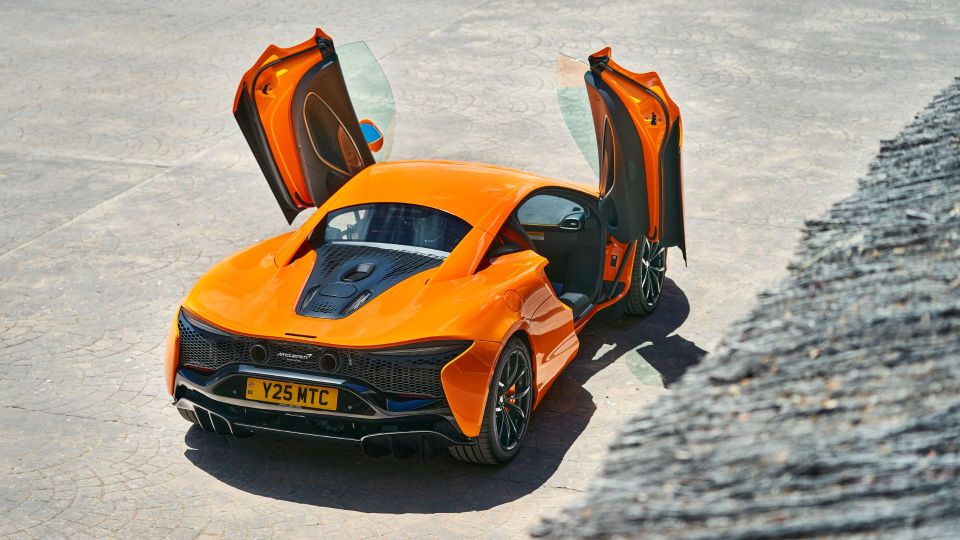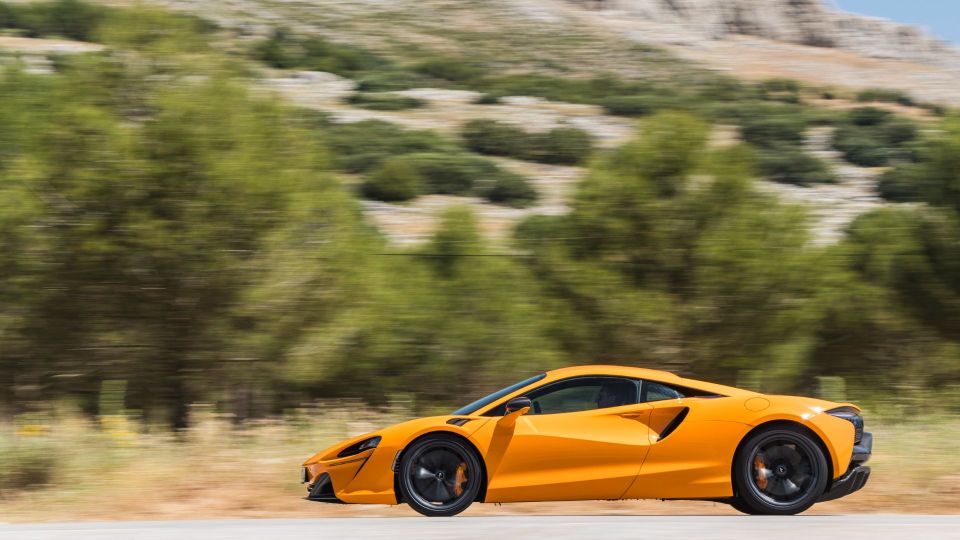McLaren Artura review: second coming for the supercar

McLaren first revealed the Artura way back in December 2020. Now, after long delays due to software glitches and semiconductor shortages, I’m finally looking at one that’s road-registered and ready to go. Journalists are supposed to remain impartial, but I desperately want this car to be good; McLaren’s future depends upon it. Thankfully, the Artura proves to be worth the wait.
Car companies often describe a model as ‘all-new’ when it has barely seen a nip-and-tuck facelift. Not so here. The Artura’s six-cylinder engine, plug-in hybrid tech, eight-speed transmission, carbon fibre tub, aluminium body, multi-link suspension, rear e-differential and Apple/Android-compatible infotainment are all entirely new.
After 11 years of reinventing the same recipe, here is the start of McLaren’s next chapter.
Having your cake…

Priced from £189,200, this is the company’s entry-level supercar, taking on the Lamborghini Huracan RWD and Porsche 911 Turbo S. The new Ferrari 296 GTB, in case you were wondering, is significantly more powerful (830hp) and a lot more expensive (£241,550)
The Artura’s heart is a 3.0-litre 120-degree V6 with two turbos nestled in its wide-angle ‘vee’. When combined with a power-dense axial flux electric motor and 7.4kW battery, total output is 680hp: good for 0-62mph in 3.0 seconds and 205mph.
Crucially, the hybrid hardware also provides an EV range of 19 miles, meaning CO2 emissions of just 104g/km. That’s having your cake and eating it.
Feeling the heat

Underwhelming in photos, the Artura has a genuine presence in the metal – particularly when you open its dramatic dihedral doors. The sinister ‘eye sockets’ of the 720S add some aggression to the swooping front end, while the rear view is draped in laser-cut mesh inspired by the P1 (McLaren’s first hybrid). A ‘powertrain chimney’ on the rear deck vents hot air from the engine at up to 900deg C.
Speaking of heat, we’re in southern Spain and the temperature is scorchio. Fortunately, my Artura has been plugged in and pre-chilled. Its Clubsport seats are a hard-shell design, but their patented elliptical movement offers a low-slung and supportive driving position.
Neat rocker switches on the instrument binnacle toggle between the drive modes and are within fingertip-reach, so the steering wheel remains free of buttons, as per McLaren tradition.
Electrifying performance

The Artura defaults to Electric mode on start-up, allowing you to glide away in near-silence – quite a contrast to the showy theatrics of most supercars. The 95hp e-motor offers ample oomph for urban driving and will stretch to 81mph beyond city limits.
Sport mode is where things get exciting, though, with the engine always on and the motor providing ‘torque infill’ and razor-sharp throttle response.
Climbing into the mountains, the interplay between petrol and electric power works seamlessly, while the dual-clutch gearbox is intuitive and brutally quick. The Artura feels caffeinated and almost precognitively alert, swatting away local Seats with nonchalant disdain.
The V6 sounds more cultured than McLaren’s venerable old V8, too, its tone hardening to feral snarl as you near the 8,500rpm redline.
The second coming

Nonetheless, like all of Woking’s road cars to date (with the honourable exception, perhaps, of the F1), the drivetrain plays second-fiddle to the chassis. Helped by a lightest-in-class kerb weight of 1,498kg, the Artura is supple enough to drive every day, yet it can also throw shapes around a circuit – as I discover at our final destination: the Ascari race resort.
In Track mode, with Variable Drift Control dialled down and its Pirelli P Zero Corsa tyres up to temperature, the Artura feels utterly tenacious: more like a hardcore LT model than a ‘standard’ McLaren, with perfect poise and huge grip. And it’s all relayed via hydraulic steering that fizzes with unfiltered feedback.
This is a multi-faceted and very modern kind of supercar, then: efficient and unobtrusive when you’re not in the mood, then riotously fast and entertaining when conditions allow. Whatever the next chapter brings for McLaren Automotive, it’s off to a flying start.
Tim Pitt writes for Motoring Research
PRICE: £189,200
POWER: 680hp
0-62MPH: 3.0sec
TOP SPEED: 205mph
FUEL ECONOMY: 61.5mpg
CO2 EMISSIONS: 104g/km